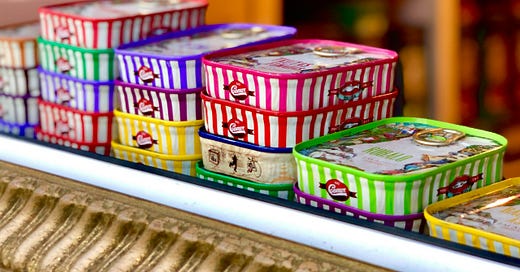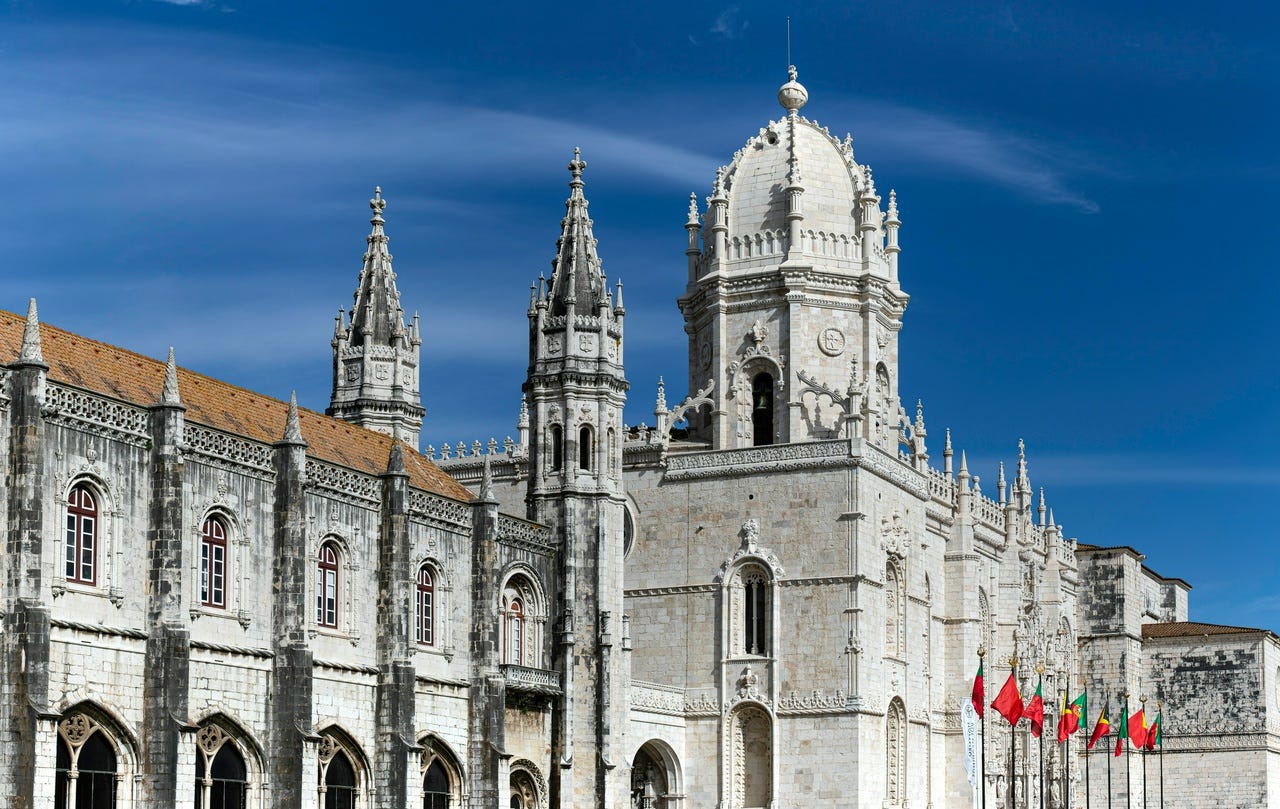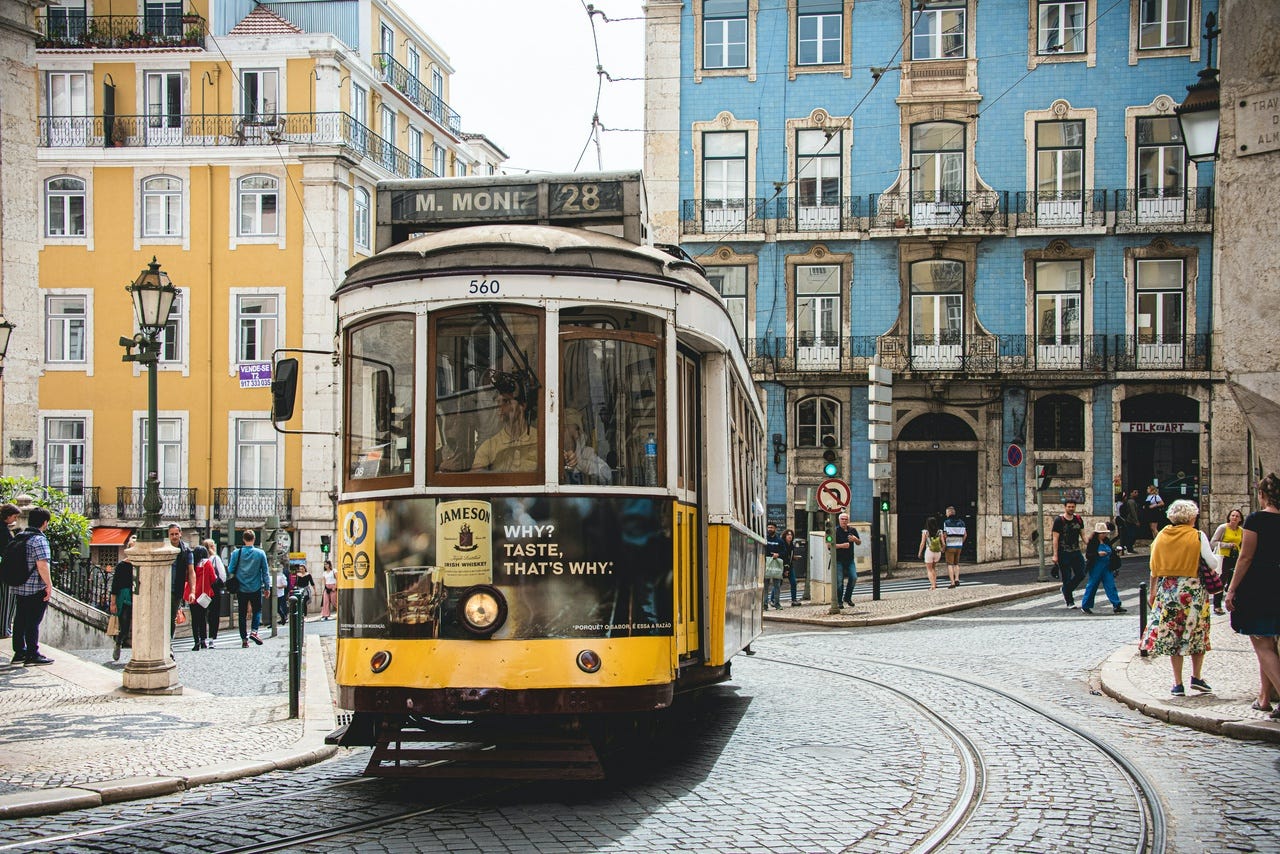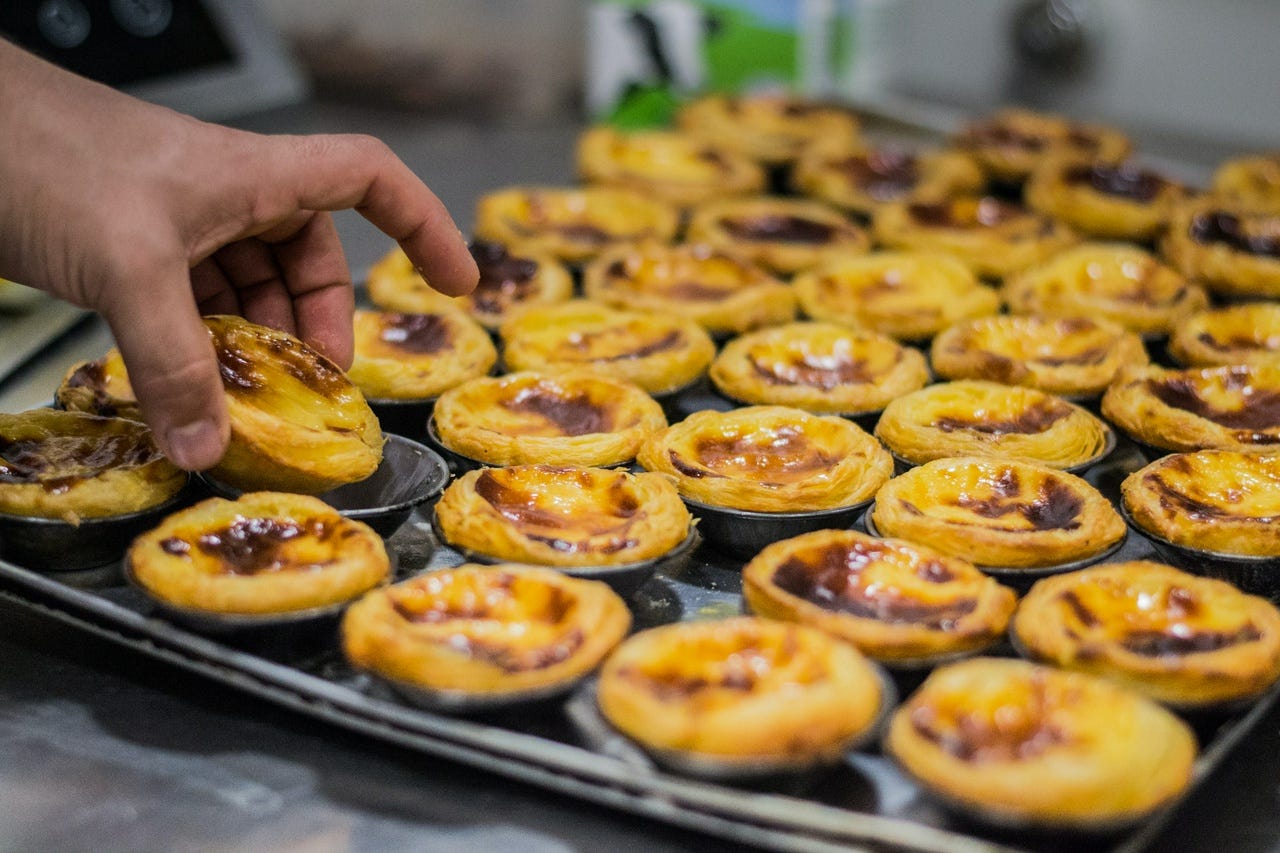When I were a lad sardines came exclusively in a tin, usually from Sainsbury’s. They were a humble fish, a regular packed lunch sandwich filling on Fridays when there was bugger all else left in the cupboard. My dad liked them on toast occasionally, but they were generally seen as a far poorer relative of red salmon (tinned of course), very much the height of fish sophistication in late-1970s working class Britain. I was well into my twenties before I tasted fresh sardines. Fiddly they may be, but they are the tastiest of fish when grilled and I was immediately smitten, and have since taken every possible opportunity to eat as many as possible.
Portugal—Lisbon in particular—is sardine paradise. Indeed, this most ordinary of fish has in recent times become part of Portugal’s national brand, as important as Cristiano Ronaldo. (You can insert your own joke about oily, slippery divers).
So much so that in the heart of modern Lisbon, opposite the Praco da Rossio is The Fantastic World of Portuguese Sardines (Mundo Fantastico Da Sardinha Portuguesa; there are several other such stores across Lisbon and, indeed, the rest of Portugal). Selling highly decorated tins of sardines for €7 a pop in a colourful if kitsch and rather bizarre setting Mundo Fantastico is more reminiscent of M&M’s World. Think of it as M&M’s World for sardines.
Each tin is adorned with a year from 1916 onwards (1916 being the year the factory which cans them first opened). You could collect the entire set if you have little else to do with €749. A little surprisingly, these tins are just about all the Mundo Fantastico sells. Chocolate sardines (available in just about every Lisbon souvenir shop, even the better ones) are conspicuously absent.
—
There is of course far more to Lisbon than sardines, although the city’s charm lies not in specific attractions: it is the kind of place that warrants, and merits, aimless exploration as opposed to simply going from sight to sight.
Quite the most majestic attraction in the city is the former monastery at Belem, the Jerónimos. A Gothic Manueline masterpiece it took a century to complete, and was made a UNESCO World Heritage Site in 1983 (along with the Belem Tower opposite, which can be visited on a joint ticket). The two-storey cloisters, complete with highly ornamental loggia, are sublime.
The monastery’s church — which can be visited for free — hosts the tomb of Vasco da Gama. As you may expect, the monastery is extremely popular: be prepared to queue for quite some time. Give the Museum of Architecture (which, although it is housed in part of the monastery, costs extra) a miss.
One of the monastery’s highlights is the former refectory, complete with its original ornamental tiles. Anyone who spends more than ten minutes in Lisbon will notice that such tiles are a feature of the city: many houses, shops and even small apartment blocks are entirely covered in them.
It is no wonder then that Lisbon also boasts a museum dedicated to them: the National Tile Museum (Museo Nacional do Azulejo). Close to Santo Antonio station, our entry point to the city, it was in fact the first place we visited. Despite boasting a priceless and quite unique collection it costs a bargain €8. Access to the superb palace in which it is housed is worth that alone. For an extra €1 you get entry to Portugal’s National Pantheon.
Lisbon’s castle, Castelo de Sao Jorge, is visible from much of the lower city and impressive from afar. Close up it’s a let down: crowded and something of a disappointment for most. Admire from outside and move on to the Se, Lisbon’s cathedral, which remains imposing despite having become rather hemmed in by surrounding buildings. The scant remains of a Roman Theatre are just up the road: take a look at the sections open to all and save yourself the price of an entry ticket.
—
The historic No. 28 tram, which climbs up and down Lisbon’s hills, passing within walking distance of all of the sights on castle hill, features on innumerable postcards and posters and is a symbol of the city. It is worth riding on. Once. Its single carriages are impossibly crowded at all times of day, and unless you climb aboard at or near one of its termini, you will be standing up the whole way, squeezed in like, well, sardines.
That’s if you can get on at all: much of the time it is so full that the driver will simply refuse to stop. (Note that the No. 28 is a regular service and requires just a standard Lisbon transport ticket. The poor people of Graça who actually rely on the tram for public transport must curse the tourists who pinch their seats). The tourist trams which run much the same route are not operated by Carris (the city’s public transport company) and require special tickets. They are also blatant cheating. Avoid.
Transport buffs should also look out for the three steep if short funiculars in Bairro Alto.
The Bairro Alto area itself is currently touted as Lisbon’s most happening district. We found it vastly overrated. It’s noisy and dare I say rowdy late at night. Prices of just about everything (food, drink and accommodation) are higher than across the city in Castelo, Alfama or Graça.
Graça in fact is Lisbon’s real gem. Aside from offering perhaps the defining view of the city (from the Miradouro do Castelo, next to the Graça Convent Church), it is home to some extraordinarily good—and cheap—restaurants. More on those in a moment.
—
About forty minutes by train from Lisbon’s Rossio station is Sintra. (Trains leave every half an hour— every hour at the weekend). The town is best known for its numerous architectural monuments: so many in fact that the entire town and surrounding area is UNESCO-listed.
Besides the overpriced shops, restaurants and cafes of the town centre, Sintra’s three main attractions are in the hills which surround it: the Pena Palace, the Moorish Castle and the Quinta da Regaleira.
The Pena Palace is the most visited of the three, and during high season queues at the ticket office can be long: get here early. The palace can be reached in about 40 minutes on foot from the town, but I do not recommend it: there is no footpath, and you will be sharing the twisting hairpins with thousands of cars. Neither, by the way, should you drive: there is very little parking, and the road so narrow in places that if you are in a hire car you might just as well say goodbye to your excess. Take the bus from the station, a taxi or an Uber (there are plenty around throughout the summer).
The 19th century palace itself—part of which was once a monastery—is an outrageously over-the-top treasure of colour and joie de vivre that somehow never descends into kitsch. Its grounds are equally fun to explore, although the map handed out at the ticket office is an endeavour of which only the Ministry of Crap Design would be proud.
You will not get lost as such, but getting to where you want to be is no easy feat. Luckily, the grounds are spectacular and few will mind temporary confusion.
The castle opposite was built by the Moors in the eighth century. It was taken Afonso Henriques, the first king of Portugal, during the Reconquista in 1147 and its military importance diminished shortly afterwards. It was badly damaged in Lisbon’s huge earthquake of 1755, and it was not until a century later that the then king, Ferdinand II, allocated funds for its preservation. While it is today mildy interesting to explore, if your time in Sintra is limited then this is the one of the big three to miss.
For many people, and I include myself here, the real jewel in Sintra’s crown is the Quinta da Regaleira, which can be easily reached on foot from the town (it takes no more than 15 minutes).
The polite term for the man who built it, Carvalho Monteiro, would be eccentric. In less polite language he was stark raving mad. But how mad!
Besides the rather mock-Gothic mansion he had built to live in, Monteiro had the grounds landscaped in the prototype of a style that would later become known as Bond villain chic. The Knights Templar and dark alchemy are all referenced, while secret tunnels (most open to the public) were built linking different parts of the grounds. The so-called unfinished and initiation wells (which you can descend) carry a certain playful menace, and you half expect man-eating alligators to emerge from the lakes and fountains at any moment. It’s all utterly bonkers and quite brilliant.
Imagine south London’s Horniman Museum with hidden tunnels and masonic motifs and you get the picture.
—
Even if you can’t stand sardines, Lisbon is paradise for anyone who loves fish and seafood. Those who don’t may struggle, for even many of the meat dishes served in these parts come complete with shellfish.
Sardines, mackerel, sea bass, sea bream, snapper and salted cod (bacalhau) are the staples, alongside prawns, clams, mussels, oysters, octopus, squid and cuttlefish. Look out too for prawn risoes (crispy pancakes filled with prawn paste): these are often brought to your table as a matter of course as an appetiser. You are under no obligation to eat them (and are not usually charged if you do not) but given that they cost peanuts and taste amazing, you would be mad not to.
What’s more, if you are prepared to get away from the city centre, Lisbon prices are cheap, as in really cheap. Cheaper than Greece cheap. Up in Graça, in a quintessentially local restaurant we frequented more than once (Satelite da Graca) a plate of sardines with salad and homemade fries cost €10. Swap the sardines for sea bass and you still get change from €15. A bottle of highly drinkable Vinho Verde cost €7. Poncey types more interested in how a restaurant looks than the quality of the food should go elsewhere, however. It is less than inviting.
We also ate decent meals next door at the equally down-to-earth Churrasco.
When visiting the Jerónimos Monastery you will no doubt see the long queues of people outside the Pasteis de Belem, all waiting patiently to buy Pasteis de Nata, a kind of custard tart which comes in a number of variations. The Pasteis de Belem (which is said to have invented the tart) churns out more than 20,000 of them each day during high season.
Are they any better than those on sale elsewhere? No. Any Lisbon bakery will happily sell you an equally (if not more) delicious pasteis without the need to queue up for half an hour.
Drink wise, none of the Portuguese beers I tried impressed me all that much (Sagres being the best of a bad bunch) but Mrs. Turp and I did like most of the slightly sparkling Vinho Verde we tasted. And we tasted a fair bit.
—
Notes
To get around Lisbon you will need a Viva Viagem card, which can be bought from all metro stations (including at the airport) for €0.50. It then needs to be loaded with credit (minimum €3) and franked each time you board a bus, tram or enter the metro (each journey costs you €1.65 in credit). You can buy single tickets on board trams and buses but these are more expensive (€2 on buses, €3 on the tram). The Viva card can be used for the train out to Sintra (if you have enough credit, of course).
The ubiquitous buzzing Tuk Tuks are to be avoided and left to those with more money than sense who are prepared to pay the extortionate fees their drivers demand.
Lisbon’s airport is all but in the city centre. It is served by the metro but an Uber or taxi will cost no more than €15 to most parts of the city. Terminal 1 is modern, spacious and a model of efficiency. Alas most low cost airlines use Terminal 2 which has seen better days.









